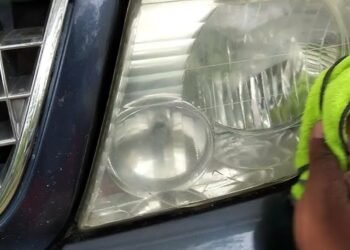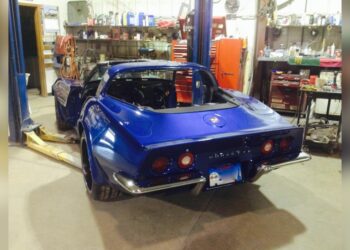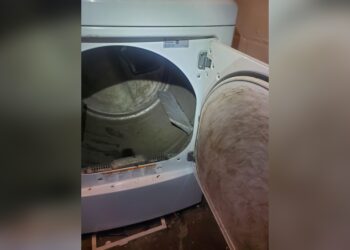Have you noticed that your car’s wheel looks pushed back into the fender? This isn’t just an odd sight—it’s a warning sign that something serious might be wrong with your vehicle’s suspension or alignment.
When your wheel shifts back into the wheel well, it can affect how your car handles, cause uneven tire wear, and even put your safety at risk. You might wonder what caused it: Did you hit a curb, or is there hidden damage you can’t see?
You’ll learn exactly why a wheel gets pushed back into the fender, what common problems lead to this issue, and what steps you should take to fix it. Keep reading to protect your ride and avoid costly repairs down the road.

Credit: www.youtube.com
Causes Of Wheel Pushed Back
The wheel pushed back into the fender signals a serious vehicle issue. Various mechanical problems can cause this misalignment. Understanding these causes helps identify repairs and maintain safety on the road.
Suspension Damage
Suspension damage often leads to the wheel moving backward. Broken or bent suspension parts fail to hold the wheel in place. This causes the wheel to shift inside the wheel well.
Bent Control Arms
Control arms connect the wheel hub to the vehicle frame. Bent control arms change the wheel’s position. This pushes the wheel closer to the fender.
Worn Ball Joints
Ball joints allow smooth steering and suspension movement. Worn ball joints create looseness in the wheel assembly. This leads to unwanted wheel movement toward the fender.
Damaged Struts And Shocks
Struts and shocks absorb road impacts and keep the wheel aligned. Damaged or weak struts cause the wheel to sag. The wheel then moves back into the fender area.
Impact From Road Hazards
Hitting curbs, potholes, or debris can bend suspension parts. These impacts push the wheel out of its normal position. The wheel may end up pressed against the fender.
Failed Wheel Bearings
Wheel bearings allow smooth wheel rotation. Failed bearings cause wobbling and misalignment. This failure can push the wheel back into the fender space.
Misaligned Wheels
Poor wheel alignment affects tire direction and position. Misalignment causes the wheel to tilt or shift backward. This places the wheel too close to the fender.
Signs Of Wheel Misalignment
Wheel misalignment often causes the wheel to push back into the fender. It affects driving safety and tire life. Recognizing the signs early helps prevent costly damage. Here are common indicators of wheel misalignment to watch for.
Tire Rubbing On Fender
When the wheel moves back, the tire may rub against the fender. This causes a scraping noise during turns or bumps. Rubbing can damage both the tire and the fender. Check for visible marks or worn paint on the fender.
Uneven Tire Wear
Misaligned wheels wear tires unevenly. Look for more wear on one side of the tire. This shortens tire life and affects vehicle handling. Uneven wear often appears as bald spots or cupping on the tire.
Steering Wheel Off-center
The steering wheel may not sit straight while driving forward. It might lean left or right even on a flat road. This happens because the wheels are not aligned properly. A crooked steering wheel signals the need for alignment service.
Vehicle Pulling To One Side
The vehicle may drift to one side while driving straight. You must apply constant steering correction to stay on course. This pulling is a clear sign of wheel misalignment. It can cause driver fatigue and unsafe driving conditions.
Inspection And Diagnosis
Inspecting and diagnosing a wheel pushed back into the fender is crucial to find the root cause. This process involves checking for visible damage and mechanical issues. Accurate diagnosis helps prevent further damage and ensures safety on the road.
Visual Damage Check
Start by examining the wheel and surrounding area closely. Look for cracks, dents, or scratches on the fender and wheel rim. Check the tire for bulges or uneven wear. Visible damage often points to impact or collision.
Inspect the wheel well for any debris or bent metal. Note any unusual gaps or misalignment between the wheel and fender. This step helps identify obvious problems before moving to mechanical checks.
Suspension System Evaluation
Next, inspect the suspension components connected to the affected wheel. Check control arms, bushings, and ball joints for wear or bending. Look for leaks or damage on struts and shocks.
Test the springs for any signs of weakness or breakage. Suspension damage can push the wheel back and affect vehicle handling. This evaluation reveals hidden issues beyond visible damage.
Wheel Alignment Testing
Perform a wheel alignment test to measure camber, toe, and caster angles. Misalignment can cause the wheel to sit incorrectly in the fender. Use specialized tools or take the vehicle to a professional shop.
Proper alignment ensures the wheel rolls straight and the vehicle drives smoothly. Detecting alignment problems early prevents uneven tire wear and steering difficulties.
Checking For Bent Components
Inspect all parts that may have bent after impact. This includes control arms, tie rods, and the wheel hub. Bent components affect wheel position and suspension geometry.
Use a straight edge or measuring tools to check for bends. Replace or repair any damaged parts to restore proper wheel fitment and vehicle safety.
Credit: www.elantraxd.com
Repair And Fixes
Repairing a wheel that has been pushed back into the fender requires careful inspection and precise fixes. Addressing the damage quickly prevents further issues and ensures safe driving. Several repair steps focus on replacing broken parts and restoring proper wheel position. These fixes improve vehicle stability and alignment.
Replacing Damaged Parts
First, damaged parts like control arms, bushings, or ball joints must be replaced. These components hold the wheel in place and control its movement. Broken or bent parts cause the wheel to shift inward or backward. Replacing them restores the wheel’s correct position and prevents rubbing against the fender.
Realigning Wheels
Realigning the wheels is essential after replacing parts or an impact. Proper alignment adjusts the camber, caster, and toe angles. This ensures the wheel sits straight and evenly on the road. Misaligned wheels cause uneven tire wear and poor handling. Realignment prevents the wheel from pushing into the fender again.
Balancing Tires
Balancing tires improves ride smoothness and reduces vibration. Uneven weight distribution in tires causes wobbling and extra stress on suspension parts. Balancing helps the wheel spin evenly, protecting suspension components from damage. It also extends the life of tires and ensures safe driving.
Strut And Shock Replacement
Worn or damaged struts and shocks affect wheel positioning and vehicle stability. These parts absorb bumps and keep the wheel aligned with the road. Replacing broken struts or shocks restores proper suspension function. This prevents the wheel from leaning or pushing back into the fender during driving.
Preventing Wheel Push Back
Preventing wheel push back into the fender is essential for safe driving. This issue often happens due to impacts or worn suspension parts. Taking steps to avoid it can save costly repairs and improve vehicle handling.
Simple habits and regular checks help keep the wheel in its proper place. Below are key actions to prevent wheel push back.
Avoiding Road Hazards
Drive carefully over rough roads and avoid potholes. Hitting curbs or large debris can bend suspension parts. Slow down on uneven surfaces to reduce stress on wheels. Watch for sudden obstacles that can cause impact damage.
Regular Suspension Maintenance
Check suspension parts like control arms, ball joints, and bushings often. Replace worn or damaged components immediately. Well-maintained suspension keeps wheels aligned and stable. Regular inspections prevent small problems from becoming serious.
Timely Wheel Alignment
Get your wheels aligned after hitting a curb or pothole. Proper alignment keeps wheels centered and prevents uneven wear. Have alignment checked during routine services. Misaligned wheels increase the risk of push back into the fender.
Monitoring Tire Condition
Inspect tires for uneven wear or damage regularly. Worn tires affect vehicle balance and suspension performance. Keep tires properly inflated to avoid extra strain on suspension parts. Replace tires before they become a hazard to wheel positioning.

Credit: www.reddit.com
Aftermath Of Impact
The aftermath of an impact that pushes a wheel back into the fender can be serious. It affects the vehicle’s safety and drivability. Understanding what to do right after the impact is crucial. The damage might not be visible immediately, but it can worsen over time. Acting quickly helps reduce further risks and repair costs.
Immediate Actions Post-hit
Stop the vehicle safely. Check for any visible damage around the wheel and fender. Listen for unusual sounds when moving the steering wheel. Look for fluid leaks under the car. Take photos of the damage for insurance purposes. Avoid driving if the wheel rubs against the fender or feels unstable. Call roadside assistance if needed.
When To Seek Professional Help
Visit a mechanic if the wheel looks pushed back or crooked. Get a full inspection of the suspension and alignment. A professional can find hidden damage to control arms or ball joints. Repair is important to avoid accidents or further wear. Schedule the checkup even if the car seems drivable but feels off. Early repairs save money and improve safety.
Potential Long-term Effects
Ignoring a pushed-back wheel can cause uneven tire wear. It may also lead to poor steering control and vibrations. Suspension parts may weaken or break over time. This increases the risk of serious accidents. Fuel efficiency can drop due to misalignment. Repairing damage early helps maintain vehicle performance and safety.
Frequently Asked Questions
What Causes A Wheel To Lean Inward?
A wheel leans inward due to worn or damaged suspension parts like control arms, ball joints, or struts. Impact damage, poor alignment, or bad wheel bearings also cause inward tilt. Inspect and replace faulty components, then perform proper wheel alignment to fix the issue.
How To Check For Damage After Hitting Curb?
Check for visible tire or rim damage, inspect suspension parts for bends or cracks, and test steering response. Visit a mechanic for a full inspection.
Why Is My Wheel Caving In?
Your wheel caves in due to worn suspension parts, bent control arms, damaged ball joints, or poor wheel alignment. Impact damage or failed wheel bearings can also cause this. Have a mechanic inspect and replace damaged components, then perform a professional alignment to fix the issue.
Why Is My Tire Slanted Inward After Accident?
Your tire slants inward after an accident due to bent suspension parts, damaged control arms, worn ball joints, or misaligned wheels. Impact can distort the camber angle, causing the wheel to tilt. Get a mechanic to inspect and replace damaged components, then perform a proper wheel alignment.
Conclusion
A wheel pushed back into the fender signals a serious issue. It often means damaged suspension parts or impact damage. Driving with this problem can be unsafe and cause more damage. Always get a professional inspection quickly. Fixing worn or bent parts restores proper wheel alignment.
Regular maintenance helps prevent this problem. Stay alert to changes in your vehicle’s handling or noise. Early action keeps you safe and saves money. Don’t ignore a wheel that looks pushed back. It needs attention right away.

















